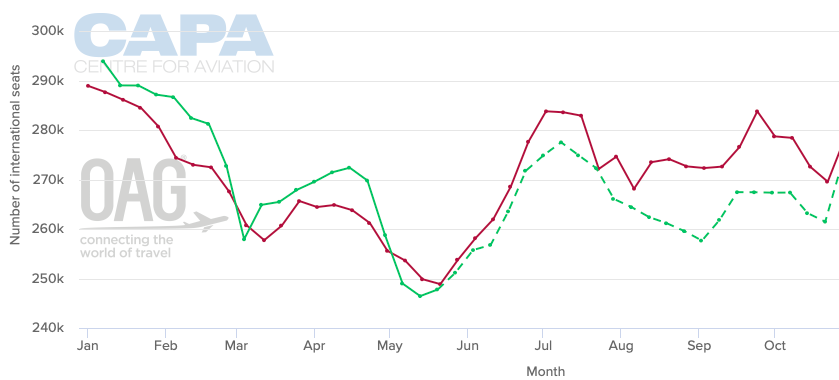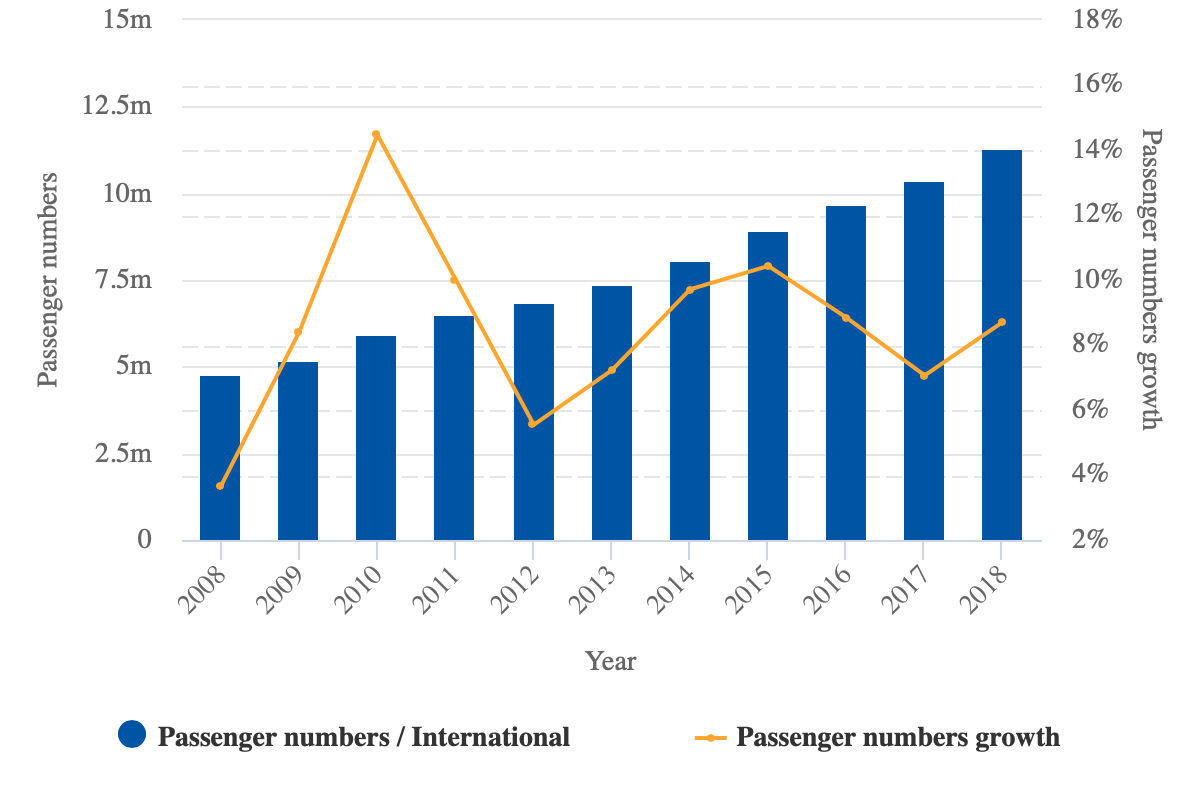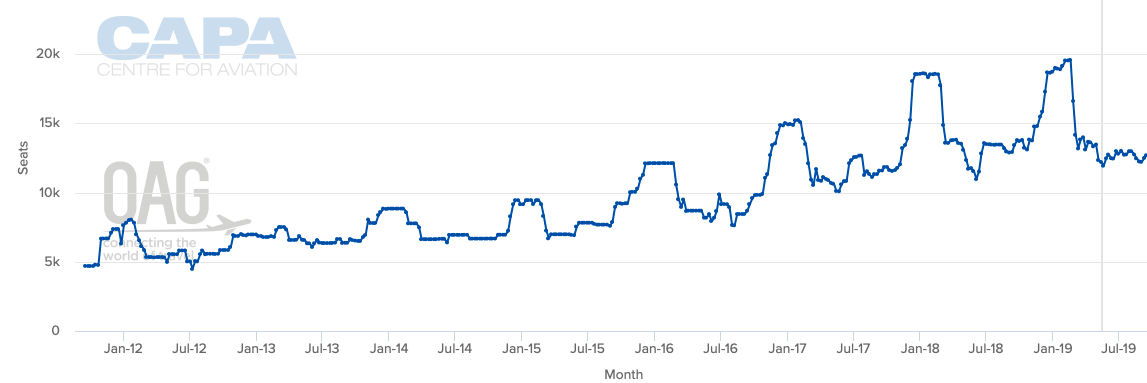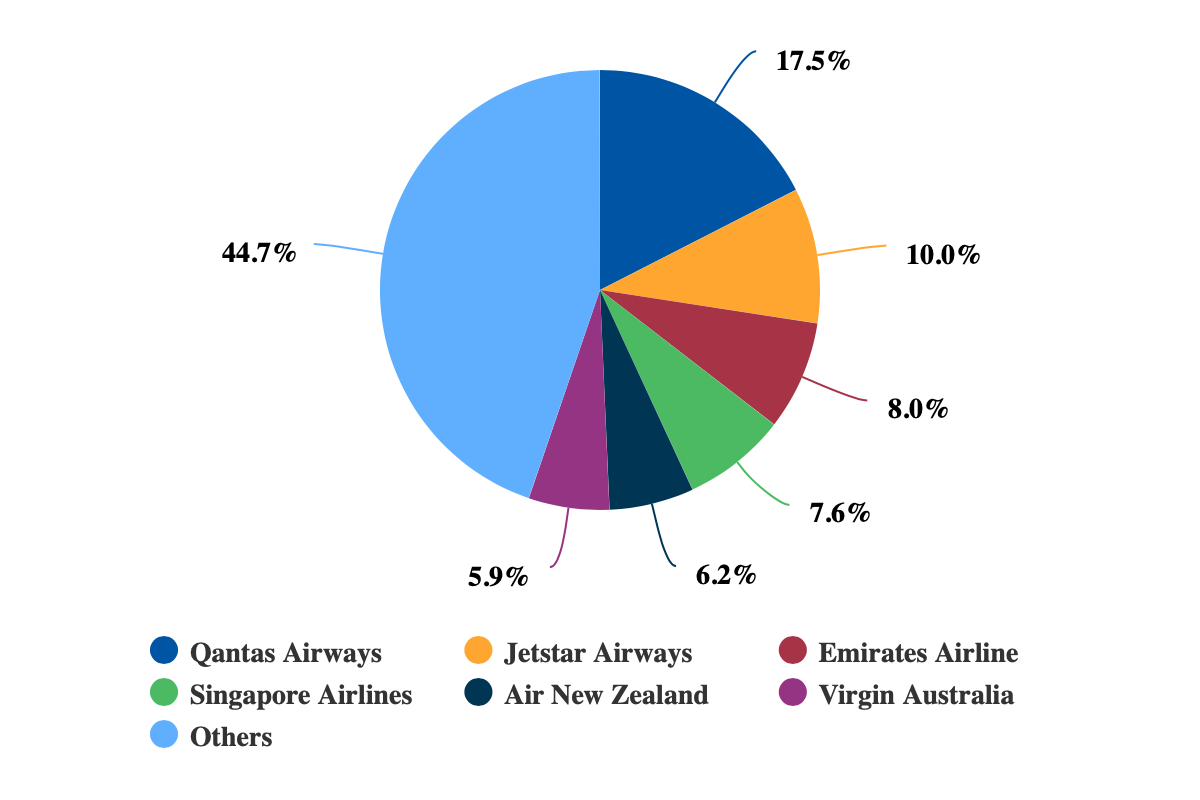Melbourne Tullamarine Airport's extraordinary decade of growth
Australia's Melbourne Tullamarine Airport has enjoyed a period of rapid international growth over the past decade. Melbourne exceeded 5 million annual international passengers for the first time in 2009 and crossed the 10 million mark only eight years later in 2017.
International passenger traffic grew another 9% in 2018 but growth is slowing considerably in 2019. China, which has been one of the main drivers in recent years, is slowing and Tullamarine lost one of its largest foreign airlines at the end of 2018 when AirAsia X moved to Avalon Airport.
Other growth markets have emerged for Melbourne in recent years, including India, Sri Lanka, Japan, the Philippines and Vietnam. These markets should continue growing, along with Indonesia and the more mature market of North America, helping fill the void.
Highlights
- Melbourne's international passenger traffic has grown by 137% over the past 10 years and by 77% over the past five years.
- Melbourne's international growth has outpaced the Australia-wide average growth rate by a wide margin.
- China has been a key driver as capacity has doubled in only four years but it is now slowing.
- Malaysia traffic is declining significantly this year due to AirAsia X's move to Avalon.
- South Asia and Southeast Asia have been important growth markets and should continue growing (excluding Malaysia).
The outlook for Melbourne's aviation market will be discussed at the CAPA Melbourne Aviation Summit on 24-May-2019. For more details on the aviation summit and the co-located corporate travel summit click here.
Melbourne international passenger traffic grew by 137% from 2008 to 2018
Melbourne's international passenger traffic has more than doubled over the past decade, from 4.7 million in 2008 to 11.2 million in 2018. Annual growth has consistently been in the high single digits or low double digits, including in the 7% to 10% range in the past five years.
Melbourne Tullamarine international passenger traffic and year-over-year growth: 2008 to 2018
Domestic growth at Melbourne has been more subdued but slightly faster than Australia's overall domestic growth rate: Australia's domestic passenger market has grown by only 8% over the past five years, whereas Melbourne's domestic traffic has grown by 12%.
Melbourne's international traffic has more significantly outperformed Australia's overall international market.
Total international passenger traffic in Australia grew by 77% over the past 10 years, whereas Melbourne's growth has been 137%. In the past five years (2013 to 2018) Australia-wide international growth has been 33% while Melbourne's growth has been 54%.
Melbourne's market share grows as Sydney's share declines
Melbourne accounted for 27% of total Australia international passenger traffic in 2018, compared to 20% in 2008. Sydney Kingsford Smith is still Australia's largest international airport but its share of total international passenger traffic has dropped from 45% in 2008 to 40% in 2018.
Melbourne has obviously benefitted from slot constraints and the curfew at Sydney. Tullamarine is a 24-hour airport and generally can meet slot requests to support new international services.
However, Melbourne has also benefitted from increasing demand in both the inbound and outbound segments. Melbourne and Victoria are increasingly popular tourist destinations.
Melbourne's international growth is slowing in 2019 and AirAsia X moves to Avalon Airport
Melbourne's growth has slowed so far this year. International passenger traffic was up by a modest 3.5% in the first two months of 2019, slightly behind the 3.6% growth recorded for the total Australia market (based on BITRE data).
International seat capacity at Melbourne for the current month, May-2019, is tracking slightly below May-2018 levels (based on CAPA and OAG data). Forward capacity data also indicates a decline for the rest of the southern winter season.
Melbourne Tullamarine international weekly seat capacity: 2019 (green) vs 2018 (red)
Australia's overall international seat capacity is down a similar amount. While Melbourne has obviously been impacted by the overall decline in Australia's international market, it has also been impacted by AirAsia X's move to Avalon Airport:
AirAsia X transferred its twice daily Melbourne-Kuala Lumpur service from Tullamarine to Avalon in Dec-2018.
See related report: Melbourne Avalon Airport: AirAsia X to spike new growth phase
AirAsia X had accounted for approximately 4% of Tullamarine's total international seat capacity. If it had not been for the loss of AirAsia X, the airport's international seat capacity would still be tracking up in May-2019. International passenger traffic for the first two months of 2019 would have increased by approximately 7% (broadly in line with the growth rate in recent years) if AirAsia X had been still operating at Tullamarine.
Malaysia traffic declines due to loss of AirAsia X
Avalon, which did not have any international services before the AirAsia X launch, handled 70,000 international passengers in the first two months of 2019. These 70,000 passengers were essentially diverted directly from Tullamarine's total and are still part of the wider Melbourne market.
Tullamarine's Kuala Lumpur traffic declined from approximately 130,000 in the first two months of 2018 to approximately 63,000 in the first two months of 2019. The Melbourne Tullamarine-Kuala Lumpur International route is still served with two daily flights from Malaysia Airlines, but capacity on the airport pair has dropped by more than 50% due to AirAsia X's move to Avalon. A third Malaysian airline, Malindo Air, also offers one-stop service from Melbourne Tullamarine to Kuala Lumpur via Bali.
Kuala Lumpur had been Tullamarine's fourth largest international market after Singapore, Auckland and Hong Kong. Kuala Lumpur is now barely in the top 10.
Melbourne is a popular destination for Malaysians and there is a large Malaysian community in the Melbourne area, including a significant student population.
Malaysia is similarly a popular destination for Melbourne residents, although the outbound segment of the market is generally smaller than the inbound segment. AirAsia X and Malaysia Airlines also rely heavily on sixth freedom traffic to fill their Melbourne flights (now Avalon for AirAsia X). Onward connections to South Asia and other destinations in Southeast Asia are particularly popular.
Kuala Lumpur had been a key growth market for Tullamarine
Kuala Lumpur accounted for 7% of Tullamarine's international passenger traffic in the fiscal year ending Jun-2018 (FY2018). Singapore accounted for a leading 13%, followed by Auckland with 12% and Hong Kong with 8%.
Kuala Lumpur-Melbourne Tullamarine traffic more than doubled from FY2008 to FY2018, growing at an almost identical pace as the overall Tullamarine market. AirAsia X accounted for almost all of this growth as it launched services to Tullamarine in FY2009 and subsequently expanded.
Malaysia Airlines' Melbourne capacity has fluctuated over the years but has been relatively flat over a 10-year period.
Over the same 10-year period Singapore, Auckland and Hong Kong grew at a slower pace than Kuala Lumpur and at a slower pace than the overall market. However, they have grown fast enough to maintain their position as Melbourne's three largest international markets.
Bali has grown the fastest among Melbourne's main international markets
Bangkok has grown at a much slower pace and therefore slipped in the rankings from being the fourth largest international market from Melbourne in FY2008 (ahead of Kuala Lumpur) to being the eighth largest (behind Kuala Lumpur, Dubai, Los Angeles and Bali) in FY2018.
Bali has been the fastest growing of the main markets, with passenger traffic growing more than fourfold over the past decade. Dubai and Los Angeles traffic numbers have more than doubled, but the rate of growth has been slightly slower than the overall growth rate.
The other top 10 markets for Melbourne are now Abu Dhabi and Guangzhou. Neither made the top 10 a decade ago.
The ninth and tenth spots were previously held by Christchurch and Wellington. These two New Zealand secondary destinations still make the top 15 (along with Doha, Shanghai and Tokyo) but did not grow fast enough over the past decade to remain in the top 10.
Top 10 international markets for Melbourne ranked by annual passenger traffic: FY2018 vs FY2008
|
Rank for FY2018 |
Destination |
Passenger traffic FY2018 |
Passenger traffic FY2008 |
| 1. | Singapore | 1,450,040 | 840,180 |
| 2. | Auckland | 1,247,393 | 705,889 |
| 3. | Hong Kong | 828,972 | 459,169 |
| 4. | Kuala Lumpur | 782,265 | 331,986 |
| 5. | Dubai | 655,022 | 299,098 |
| 6. | Los Angeles | 620,341 | 306,235 |
| 7. | Bali | 527,961 | 121,830 |
| 8. | Bangkok | 474,629 | 401,354 |
| 9. | Abu Dhabi | 398,069 | N/A |
| 10. | Guangzhou | 382,696 | 45,671 |
| N/A | Christchurch | 362,144 | 281,676 |
| N/A | Wellington | 199,745 | 142,580 |
China has accounted for the largest share of recent growth
Abu Dhabi was not served at all in FY2008 as Etihad only launched services to Melbourne in 2009. Etihad added a second daily flight in 2015, enabling Abu Dhabi to push into Melbourne's top 10.
China Southern has been operating Melbourne-Guangzhou for 20 years, but 10 years ago the service was still less than daily. The route is now served three times daily in peak southern summer season - and with 10 to 14 weekly flights the rest of the year - making it the tenth largest market from Melbourne.
China overall has been the biggest growth story for Melbourne. In addition to Guangzhou growing more than eightfold (from a very small base), Beijing and Shanghai have grown rapidly over the past decade.
Melbourne-Beijing traffic has grown from 30,000 passengers in FY2008 to 107,000 passengers FY2018. Melbourne-Shanghai traffic has grown from 97,000 passengers in FY2008 to 304,000 passengers in FY2018.
A staggering 10 new destinations in China have also been launched over the past decade - Changsha, Chengdu, Chongqing, Haikou, Hangzhou, Qingdao, Shenzhen, Xian, Xiamen and Zhengzhou.
Combined, these secondary routes generated more than 300,000 passengers in FY2018, resulting in over 1 million nonstop passengers for the total Melbourne-China market. (This data excludes one-stop Melbourne-China traffic; a large proportion of Melbourne-China traffic transits in other Asian gateways, such as Hong Kong, Kuala Lumpur and Singapore.)
Melbourne has attracted nine new China routes in only three years
Nine of the new China routes have been launched since the beginning of 2016. The only secondary China route that has been operating for more than three years is Chengdu, which was launched by Sichuan Airlines in 2013.
In 2016 Hainan Airlines launched Changsha, Beijing Capital Airlines launched Qingdao, Hainan Airlines launched Xi'an, and Xiamen Airlines launched Xiamen.
In 2017 China Southern launched Shenzhen, Jetstar Airways launched Zhengzhou, Tianjin Airlines launched Chongqing and Xiamen Airlines launched Hangzhou. Most recently, in late 2018, Hainan Airlines launched Haikou.
No services are currently operated on the Changsha route; it was suspended by Hainan Airlines in Oct-2018. However, all of Melbourne's other secondary China routes are still being operated. They all have year-round service, although reductions during the offpeak season are typical (there are also seasonal reductions on the primary routes).
The fact that 90% of the new China routes have been maintained is an impressive accomplishment given the typical failure rate of new routes. However, some of the routes are likely being maintained for political rather than commercial reasons. Overcapacity in the Melbourne-China market, and the broader Australia-China market, is a concern - both for Chinese airlines and for potential Australian competitors. Meanwhile, tourism and airports are the beneficiaries.
Melbourne-China seat capacity doubled in just four years
There are currently 45 to 69 weekly nonstop flights from Melbourne to mainland China (depending on the time of year).
Eight Chinese airlines serve Melbourne. Jetstar has the only service by an Australian airline, operating just two weekly flights to Zhengzhou on a scheduled charter basis.
Seat capacity in the Melbourne-China market has broadly doubled over the past four years - from up to 9,500 one-way seats in 2015 to up to 20,000 one-way seats in 2019. Off-peak capacity has increased from approximately 6,500 one-way seats in 2015 to 12,000 one-way seats in 2019.
Melbourne Tullamarine-China one-way total weekly seat capacity: Sep-2011 to Sep-2019
China has been an important contributor to Melbourne's rapid international growth over the past five years and will continue to be an important driver. Yet another new China route from Melbourne will be launched on 28-May-2019 when Sichuan Airlines begins service to Guiyang.
However, China growth is likely to slow as China visitor growth to Australia slows. Chinese visitor numbers to Australia increased by only 1% in 1Q2019. The rate of growth started slowing in 2018, when there was a 6% increase in Chinese visitors to Australia, ending a string of eight consecutive years of double digit growth.
Melbourne grapples with reductions from Thai Airways and LATAM
Melbourne will need to find other markets to maintain the high single digit to low double digit rate of international passenger growth that it has been able to achieve consistently in recent years. These new markets are not only needed to fill in for a slower China, but also to fill the gap left by the loss of AirAsia X and reductions from other foreign airlines.
For example, Thai Airways cut Melbourne from 14 to 11 weekly frequencies in Oct-2018 and Emirates dropped its daily Melbourne-Auckland service in Mar-2018. In Aug-2019 LATAM Airlines is reducing Melbourne-Santiago from five to three weekly flights and is further cutting capacity on this route in Oct-2019 when it downgauges from 313-seat 787-9s to 247-seat 787-8s.
LATAM had been a key contributor to Melbourne's growth in 2017 and 2018. The Chile-based airline group launched Melbourne in Oct-2017 with three weekly 787-9 frequencies and added two more 787-9 frequencies in Dec-2018.
South Asia is an important growth market
Colombo in Sri Lanka was another new market launched at the same time as Santiago. SriLankan Airlines entered the Melbourne market, its first destination in Australia, in Oct-2017 and has since operated a daily service.
SriLankan has relied heavily on connections to India, which is an underserved and fast growing market from Melbourne. Air India offers the only nonstop service from Melbourne - or anywhere in Australia. Air India has only three weekly flights to Melbourne and four weekly flights to Sydney.
Melbourne is keen to attract more nonstop flights to Delhi (from Air India or other airlines), as well as a new nonstop service to Mumbai. India is an important market for Melbourne - both the airport and the region's tourism industry - and could unlock a new phase of international growth at Tullamarine.
Bali and Manila markets are on the rise
Indonesia, Japan, the Philippines and Vietnam have also emerged as important growth markets for Melbourne.
Melbourne-Bali capacity has increased by approximately 30% over the past year (May-2019 vs May-2018), driven by new services from Malindo and Qantas. This market could potentially attract more new capacity, given the continued rise in demand for Bali as a holiday destination for Melbourne area residents.
See related report: Melbourne-Bali market: Garuda, Jetstar and Lion Group respond to under-capacity by adding flights
Tullamarine is also keen to attract more services to Jakarta, which is now only served by Garuda with a less than daily service. New secondary destinations in Indonesia are also a possibility.
Melbourne-Philippines capacity has tripled over the past year due to the launch of flights from Cebu Pacific and additional flights from Philippine Airlines. While it could take some time for this surge in capacity to be absorbed, further growth is possible over the medium to long term - given the rise in demand for Melbourne-Philippines travel from both ends.
Melbourne-Manila was previously underserved, as was Melbourne-Bali, resulting in a large number of passengers travelling via Sydney or other points.
Vietnam, Hong Kong, Japan and Korea markets have growth potential
Melbourne-Ho Chi Minh capacity increased by approximately 50% in 2017 when Jetstar started competing against Vietnam Airlines. Tullamarine could potentially attract more new capacity to Ho Chi Minh as well as a new service to Hanoi, which is now served from Sydney (by Vietnam Airlines) but not yet from Melbourne.
Melbourne-Tokyo capacity similarly increased by approximately 50% in 2017 as Japan Airlines launched services alongside its partner Qantas. The Melbourne-Japan market could support further growth, including a potential new route to Osaka (which is already served from Sydney and Cairns).
Melbourne is also keen to regain a link with Seoul in South Korea. Seoul is now served from Brisbane, Sydney and (from Dec-2019) the Gold Coast.
In the Melbourne-Hong Kong market, capacity increased by approximately 20% in 2017 as Virgin Australia started competing against Cathay Pacific and Qantas. This is another market which could potentially support more capacity.
Virgin Australia is still a relatively small competitor in the Melbourne international market. It has only a 6% share of capacity compared to nearly 18% for Qantas. Emirates and Singapore Airline are the largest foreign airlines, each accounting for around a 8% share of total international seat capacity at Tullamarine.
Melbourne international capacity share (% of seats): week commencing 13-May-2019
More North America growth is also potentially available
Further growth to North America is possible but is likely to be at a relatively modest pace, given that North America is a more mature market than Asia.
Melbourne has benefitted over the past year and a half from new links to Vancouver by Air Canada and to San Francisco by Qantas. Melbourne could potentially support more capacity from Air Canada (which currently operates up to four weekly flights) and attract a second route from United (which only serves Los Angeles but could launch San Francisco).
Honolulu is also a potential growth market as it is only served by Jetstar at the moment, with up to four weekly flights. Hawaiian Airlines is an obvious target and would also offer a one-stop option to the mainland US.
It will not be easy for Tullamarine to keep up the momentum after recording five consecutive years of international passenger growth of at least 7%.
A slowing Chinese market and the loss of AirAsia X are concerns. However, there are potential opportunities in other markets for Melbourne to fill these voids and continue posting healthy, albeit slower, international growth rates.
Australia's slumping dollar will gradually impact air services
A combination of tourism flows and airline revenues are greatly affected by fluctuating currency levels. As the AUD dips below USD69cents, the complexion changes for Australia's attractiveness as a tourism destination, as well as the revenue streams that airlines use to justify their presence on a particular country pair.
Sentiment suggests the AUD will continue at its depressed level - it is almost at its lowest against the USD in the past 10 years. This makes the Australian tourism market more attractive to foreign visitors whose currencies track the USD more closely, but also makes the market less attractive for foreign airlines which rely predominantly on Australians travelling outbound.
It is a sensitive but important balance, whose effects filter through progressively. Here, Melbourne Airport will be affected along with the wider Australian market.



